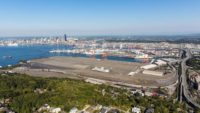An expansive walkway over taxiways is the highlight of the planned new International Arrivals Facility at Sea-Tac International Airport, south of Seattle. The 900 linear ft of aerial walkway will soar 85 ft over the active airfield to connect arriving international passengers from the south satellite to the new facility.
The $660-million project is funded by airport-generated revenues, passenger facility charges and revenue bonds.The Port of Seattle expects to build a multilevel, 450,000-sq-ft facility, breaking ground in the first quarter of 2017 and opening it by the end of 2019.
“Our international travel continues to grow at a double-digit pace, but what welcomes international travelers to Sea-Tac is a cramped, 1970s facility that is well beyond its planned peak capacity,” says John Creighton, Port of Seattle Commission president, in a statement. “The IAF project is a critical investment for the region’s economy that will create a proper welcome mat for both business and leisure travelers.”
Clark Construction Group of Maryland leads the design-build group, which includes architecture firms Skidmore, Owings & Merrill, Chicago; Schlaich Bergermann & Partner, Stuttgart, Germany; and The Miller Hull Partnership, Seattle. The team also includes Arup (mechanical, electrical, plumbing), KPFF (structural) and MKA (civil).
The new structure will upgrade Sea-Tac’s current facility, which has long exceeded its capacity, by expanding east of the current Concourse A and more than doubling passenger capacity, to 2,600 passengers per hour, with 80 passport-check booths and kiosks, seven baggage claim carousels, and improved passenger flow to baggage claim and ground transportation.
But the most visually striking component includes the elevated walkway. Perry Cooper, Port of Seattle spokesperson, says the plan involves building the overhead walkway at the north end of the airport in the corner of a cargo area. “Once that is built, we will move it along the airport taxiway to the location and install it in one piece,” he says. Crews expect installation to wrap within seven days once the walkway is moved into position.
The walkway connects to Concourse A, where a secure international corridor, raised nearly 32 ft above the aircraft apron, will allow for more gates for arriving international flights.
International passenger activity requiring customs clearance at Sea-Tac, the country’s 13th-busiest airport, has more than doubled in the past 10 years, growing 105% from 2005 to 2015. Cooper says a consultant’s study estimates each new international route generates $75 million in annual economic impact to the region.






Post a comment to this article
Report Abusive Comment